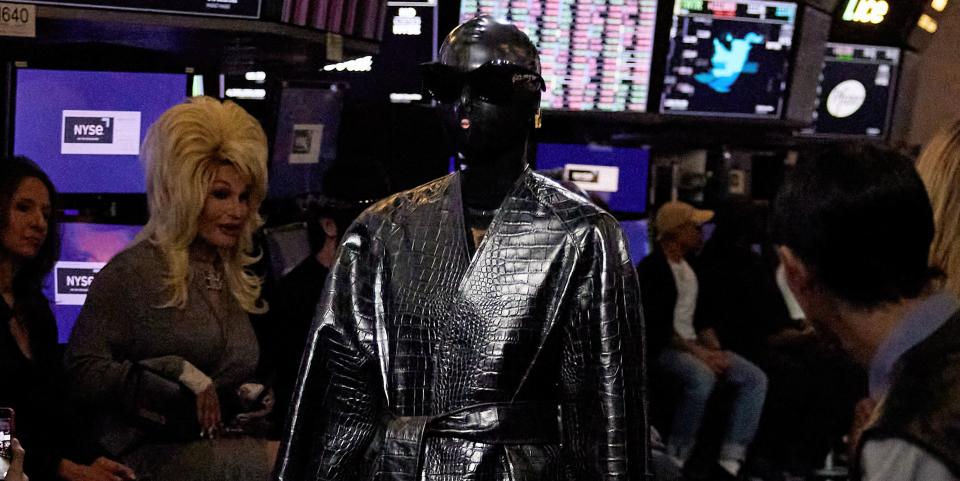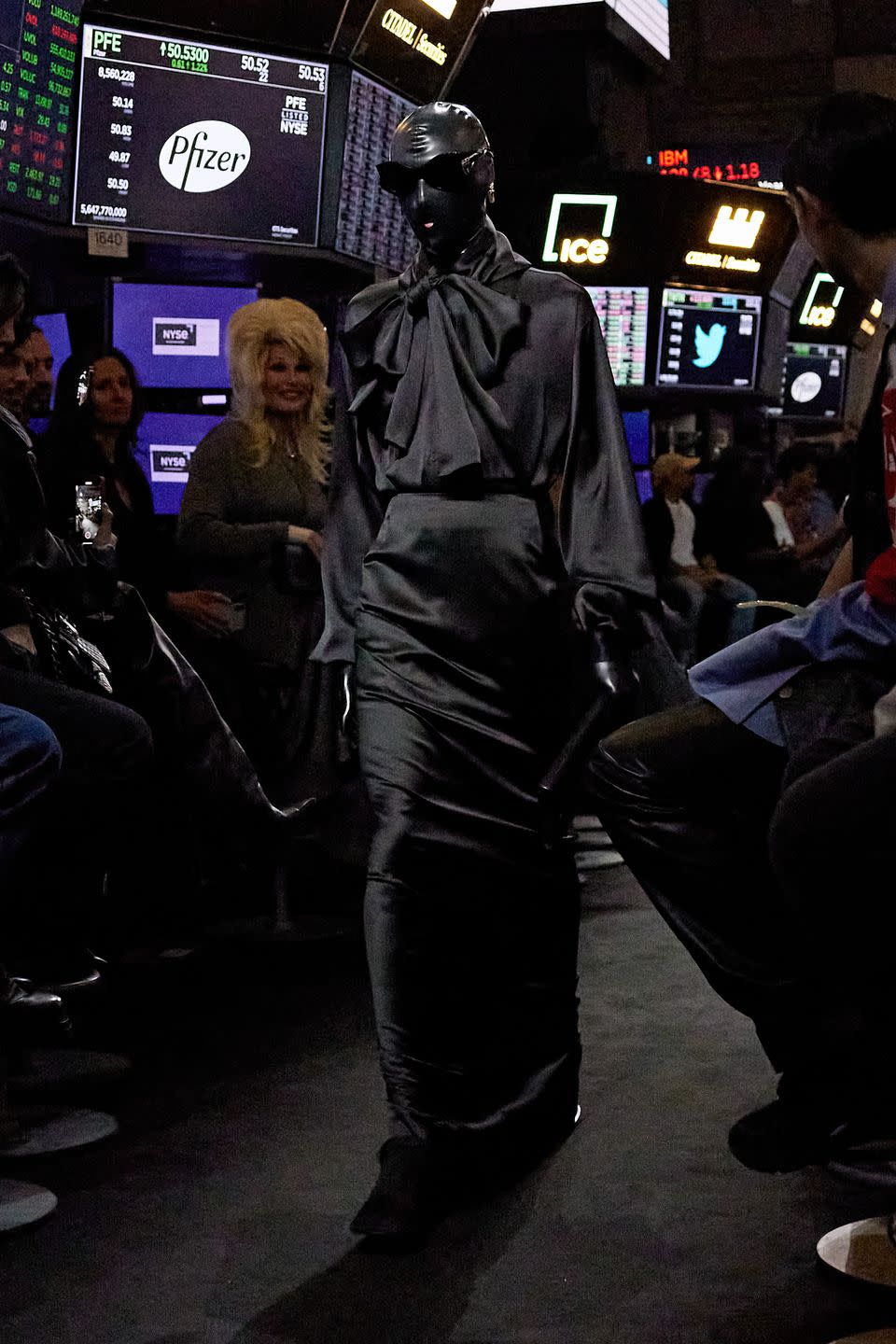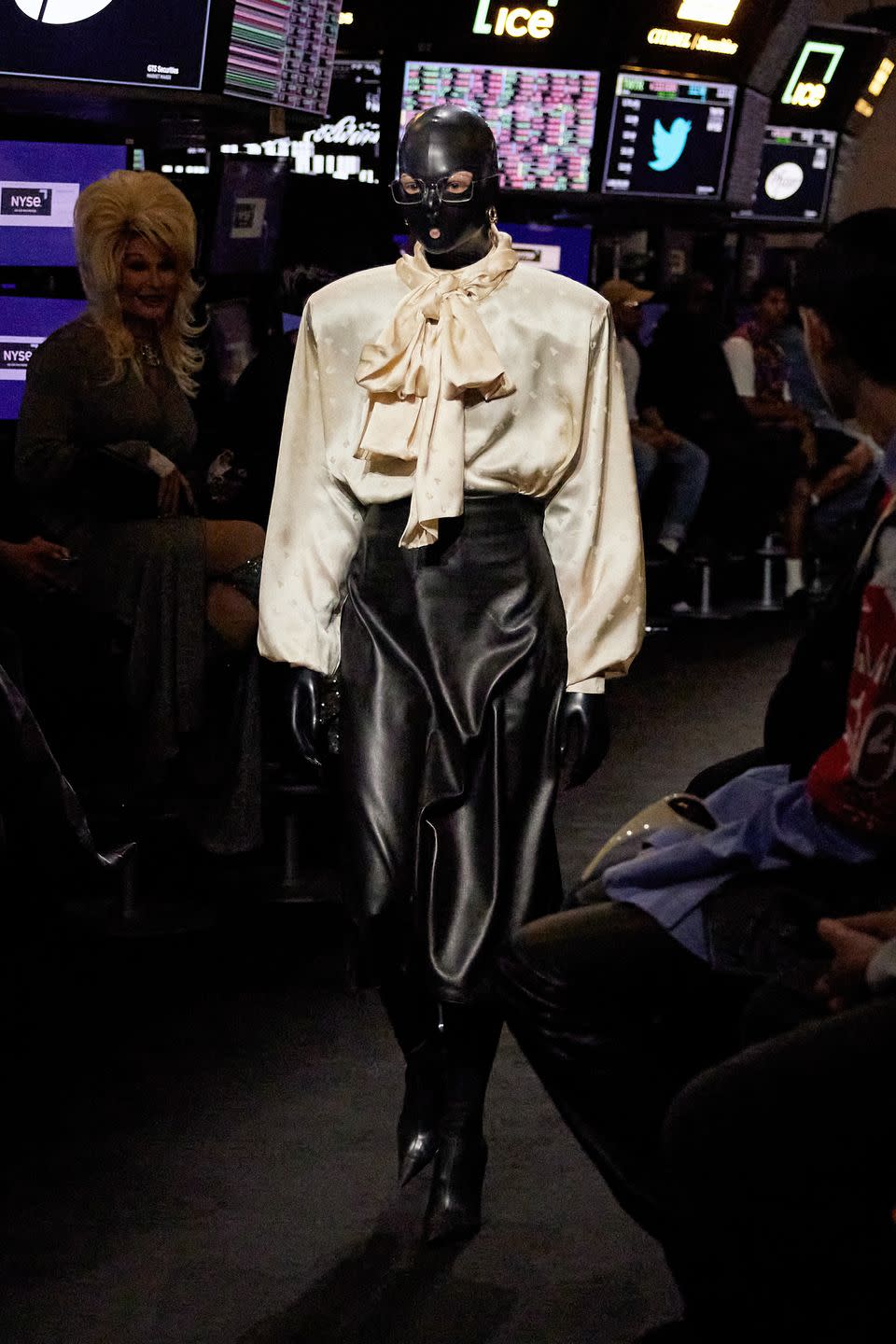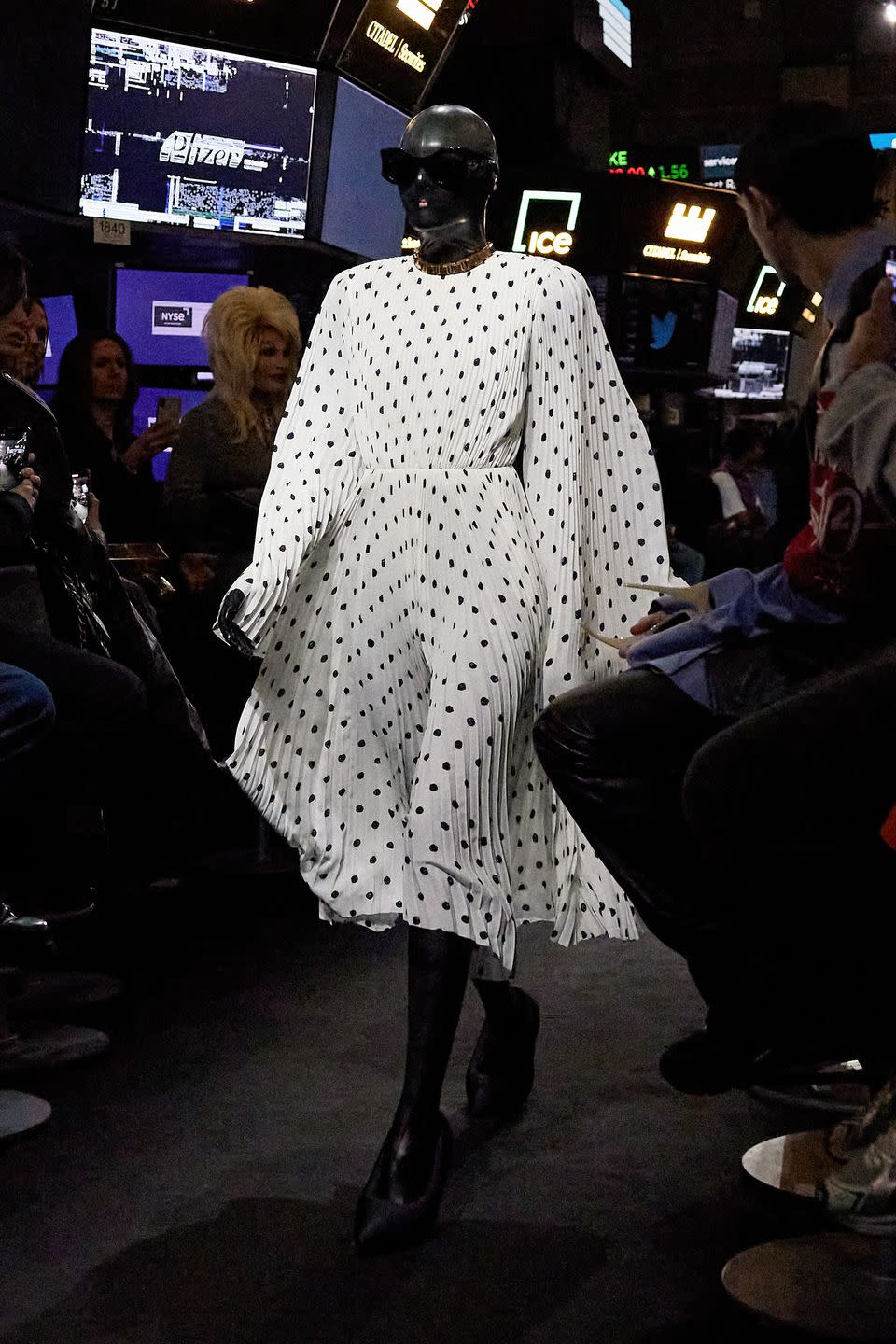Balenciaga hosts show at the New York Stock Exchange

Balenciaga creative director Demna Gvasalia has been hovering on top of the fashion world for almost eight years now. But how do we define his role? Is he fashion’s best comedian? When asked why he collaborated with Adidas for his Spring 2023 show, staged on Sunday in Manhattan, he said, “Well, I always wanted to use three stripes.” Ha! Or, with his pounding music and gimp-mask covered models, maybe he is fashion’s best horror director?
The only thing we can say for sure is that he is our most influential living fashion designer – so anthropological is his work that the whole world has looked like Balenciaga over the past few years, whether it’s the tourists on the street outside of the New York Stock Exchange, where the show was held, or the world’s wealthiest people, who always seem to have the worst clothes. He holds a mirror up to — well, not nature, but all that is highly synthetic and banal and overly familiar. Demna makes you feel seen, but in a bad way.

That was the primal pleasure of his New York show. This is the first time Demna has shown in America, though he noted backstage that Americans were some of the first to embrace his Balenciaga vision. A country never looks so pure as through the eyes of a foreigner, and Demna, who is Georgian and designs out of France but lives mostly in Switzerland, showed us Americans (especially New Yorkers) as he sees us: work obsessives with briefcases and blazers, CFOs in big black coats. His models tramped through the stock exchange like they owned the place, their precise power-hungry tailoring punctuated with enormous black clown shoes. Every model wore a bondage suit under their look. You know...because we’re slaves to capitalism.
Surely I’m not the only one who’s tired of because capitalism!-type thinking, a dominant strain of complaining online (and also off) that blames all the ills of the world with a shrug on the behemoth machine of economic power. Maybe the reason why it works when Demna creates these sweeping, chilling visions of global force is that he is embracing the obvious (in fact, he is fascinated by it). A lot of artists, thinkers, and creative people hesitate to do that. As weird as Balenciaga is, Demna has propelled the brand to its perch of influence by embracing things so plain and simple and ubiquitous that we see them anew: Kim Kardashian, celebrity divorces, The Simpsons. And now: America!

America is greedy and dark and “money is probably the biggest fetish in the world,” as Demna said backstage. America is so much about aspiration, about trying to be what we want to be, that it’s effective (and also, we must admit, comedic) for someone to simply state what we are.
On top of all this is the totally awkward reality that fashion shows are supposed to make you want things, and also make you want to be someone else. You sit there squirming in your seat trying to figure out if it’s okay to think that this bespectacled figure in a gimp suit under a beautiful navy robe coat and a briefcase, their latex-clad long nails clutching a to-go coffee, looks really freaking cool. It’s the comfort with pure ambiguity that makes the experience singular, especially in a fashion world currently dominated by overt moral messaging.
Beneath all that unsettling narrative were some fantastic clothes. The first half of the show, comprising those corporate honcho separates of suiting, beautiful coats, sinewy skirts, pussybow blouses, and macho blazers, are part of a new line the house is launching called Garde-Robe. “I would say [these] are upscale, classic garments, as opposed to our usual seasonal fashion that we do,” Demna explained backstage. “It's really more about the fit and tailoring.”

He was inspired by his banger couture show of last July, in part, when he spent months obsessively fitting a single jacket, and while the pieces are made in the same factories as his ready-to-wear, Garde-Robe is meant to be, somewhat like his first couture offering, “a classic wardrobe.” There wasn’t a single logo in sight, and the cut and quality of a black, sharply arched shoulder coat, or a robe-like coat that hung off the shoulder like a perfect curtain, gave me a feeling of discernment I usually get looking at craftsmanship-obsessive brands like Loro Piana or Max Mara.
The pant and skirt suits in particular, along with the nearly all-black palette, reminded me of the snobbism of fashion in the 1990s and early 2000s, especially in New York, when to wear colours and prints was considered gauche. Minimalism back then, like, say, Carolyn Bessette-Kennedy in a tight black Yohji skirt and big ole white shirt, was a form of hearty pretension, a sign that you were not for everybody. Black was shorthand for money, intellectualism, and power. Now, minimalist dressing is like shorthand for an orderly, Instagram-friendly life. Demna mentioned one of the reasons he put all the models in masks was to reflect “the idea of fashion erasing the identity of people today. Everybody jumps on [a trend] and ends up looking the same.” I like the idea of clothing that, however classic, is a bit difficult to understand.
Garde-Robe will be a bit more expensive than the ready-to-wear, and the garments will be made in France. And the concept is quite provocative, since Demna has been such a keystone of the hype machine, with his Triple S sneakers and zillion-layer jackets and LOL-ish T-shirts. What might this concept do to the idea of desire itself? Potentially, it marks a shift in Balenciaga’s obsession with the fake and digital – its video game show in late 2020, and its dalliances in the metaverse — to something more “real” and small. Or at the very least, a new interest in fashion that feels obscure.

The second half of the show had me less enthused: a collaboration with Adidas. The German brand is partnering up with everybody: first Prada in 2019, then Gucci in March, now Balenciaga, and in between, Wales Bonner. Bah. The pieces were cool — especially the leather backpacks and duffle bags. The clothes were many familiar Demna-isms, like robe coats and long shorts and big track jackets. (I suppose if you are a Demna-ologoist, you might find it hilarious that the designer who first became famous for remixing logos with the name of his first brand, Vetements, is now getting paid untold sums to do exactly that.)
Demna knows, perhaps, that if he’s going to go all-in on this logo-less, tailored clothing, proposing an antique monster’s theory of elegance, he has to give people things that feel like products before everything else, as well. “The biggest, most important challenge for any kind of creative is to make product that is desirable, to create desire,” he said. “That’s what fashion should be. And that’s what we are trying to do everyday, in a way. Sometimes it creates less desire, sometimes more, but I think the commercial success of a product is linked to that desirability, whether it’s a bag shoe or a consumer dress or whatever it is.”
What it seems that Demna hopes, though, is that our common definition of desire might shift. That we will develop more of an interest, first of all, in complicated and enigmatic ideas. And that the intensity of our desire — the fire that compels us to endlessly shop for fast fashion, stand in line for hoodies we forget about after a week, and scramble like mad people for sneakers that appear suddenly out of thin air — doesn’t waver, but rather we direct it towards something more deserving, like a beautiful blazer, or an evil cocktail dress with a gold necklace, or a demonically beautiful robe coat pinched from the wardrobe of the horrifying, ambiguously powerful.
You Might Also Like

 Yahoo Finance
Yahoo Finance 